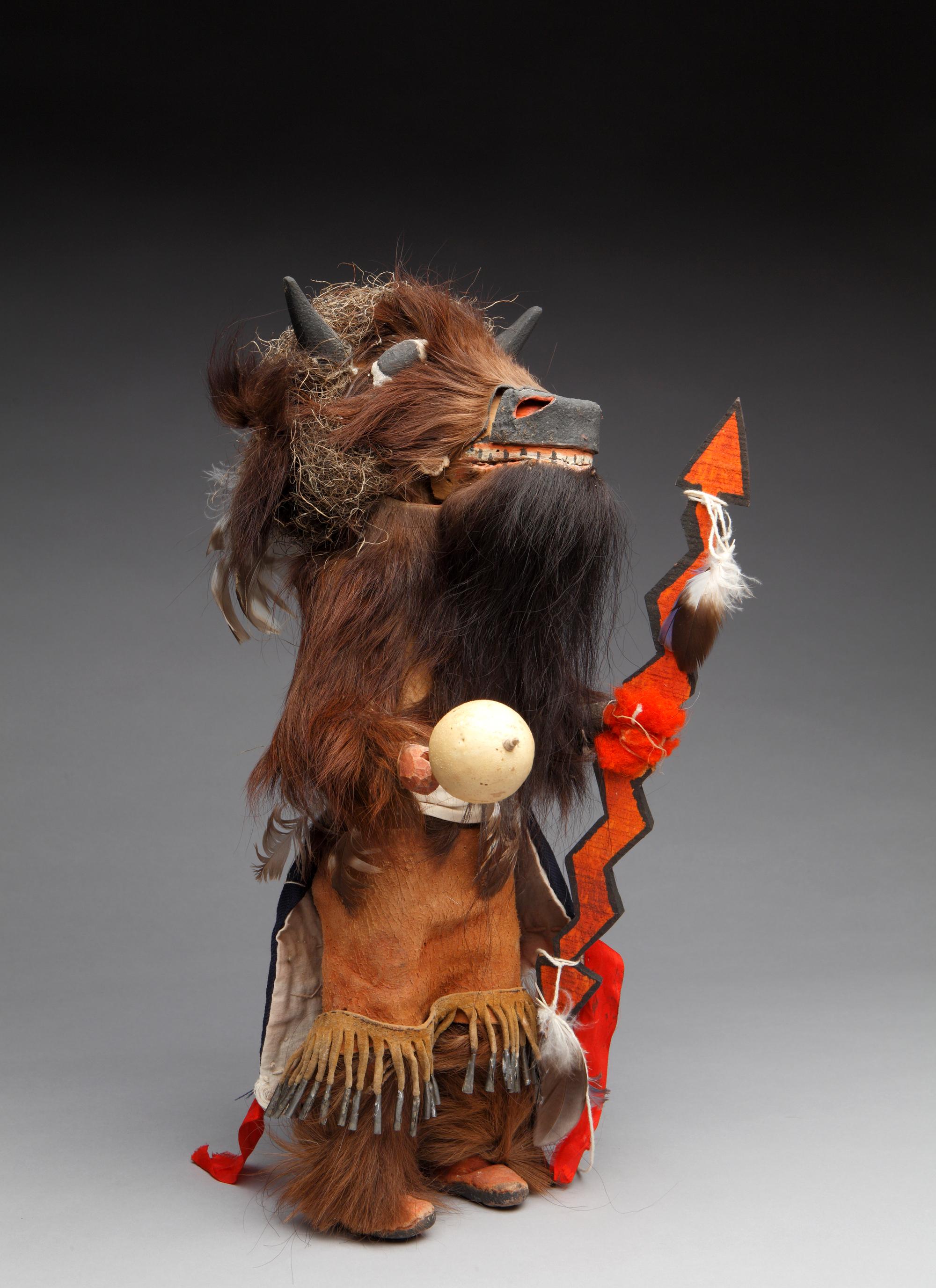
Front of kokko.
Photograph by Addison Doty. Copyright 2014 School for Advanced Research.
Ciwolo kokko we'ha | Buffalo kokko figure
Date: 1895-1925
Artist or Maker: Unknown
Dimensions:
Overall: 40.6 cm (16 in.)
Medium: wood | paints | feathers | leather | tin | cloth | hide | silk | fur | wool
Credit Line: Indian Arts Fund purchase for the permanent collection.
Place Made:
Zuni Pueblo, McKinley County, New Mexico, Southwest, United States, North America
Object Number: IAF.C2
Not on view
Tribal Collection Review RemarksJim Enote and Octavius Seowtewa during collection review visit April 6 and 7, 2009 (Events Record “Collection Review: Zuni Tribe, Review 1”): Ciwolo (Buffalo) comes out with four other kokko that make one group. This group of five includes Girl, Warrior, Boy, Ah-Na-Nu-Aya-Ha (SAR.1978-1-138) and Ciwolo. Ciwolo can also come out with other dancers such as Ah-Na-Nu-Aya-Ha (SAR.1978-1-138) and La' Bilawa (SAR.1989-7-28). There may be twenty or more other kokkos dancing with Ciwolo.
The item was isolated in plastic sheeting at the time of the review due to suspected clothes moth activity. Mr. Enote and Mr. Seotewa said this was acceptable for purpose of treating the insect infestation.
ADDITIONAL INFORMATION: Jim Enote and Octavius Seowtewa during collection review visit April 10 and 11, 2014 (Events Record “Collection Review: Zuni Tribe, Review 13”): This kokko is made of carved wood which is covered with buffalo hide with the hair still on. The course hair on the top and back of the figure’s head is from a buffalo’s head, the part between the horns. There are two hawk feather fans attached to the back of the kokko’s head. (The feathers on the dancer would be from a Harris hawk, but these feathers are from a different hawk.) The hair on the figure’s snout is cut above the nose, to make it shorter like it would be on a buffalo’s face. The nose is covered with buffalo leather that is painted black, with red-rimmed nostrils. The mouth has painted teeth. The horns are made of wood and painted black. They are tied onto the head. The eyes are made of hide that was shaped into a rounded form and painted white with large black pupils. The figure’s beard is also made from buffalo hair.
The kokko’s arms are painted red, probably with paint made from red hematite. On the left arm, it wears a black leather bow guard with brass metal decoration on it. The left hand holds a lightning staff, carved from wood in the shape of a lightning bolt. It is outlined with black paint on both sides, and painted red on one side and a greenish-yellow with hints of blue on the other side (it’s supposed to be blue). Eagle body feathers and blue bird feathers are tied to each end of the staff with piece of white cotton string. The staff is wrapped with red yarn in the center, at the point where it is being held by the figure’s hand. It’s held to the hand with a piece of natural sinew that is wrapped around the hand and the staff. The right hand holds a rattle made from a real gourd. The gourd is held to the rattle stick with white cotton string that has been wrapped around the stick at the points just above and below the gourd. The rattle was originally fastened to the hand with a piece of sinew, but it has been repaired with nylon thread.
There are two 3-inch hawk feathers present at the figure’s waist. They’re probably remnants of a feather belt like the one that would be worn by a buffalo kokko dancer, which only has feathers on the front portion of the belt. The figure wears a brain-tanned leather kilt dyed brown, with a brain-tanned fringe at the bottom that is dyed yellow and has tin tinkler cones at the ends of the fringe. A white muslin sash with blue ends is tied over the top of the kilt, with the ends of the sash falling on either side of the figure. The blue portions of the sash have simple white embroidery on them and are edged at the ends with a strip of red material. A piece of fox fur representing a fox pelt is tied in back, over the sash.
The figure wears leather, handmade moccasins. The uppers are red and the soles are black.
There are a couple of pieces missing from the kokko’s clothing, compared to the way the dancer would be dressed. There should be a bracelet on the right wrist and turtle rattles tied to the backs of both legs, just below the knees.
In Collection(s)
Bibliography:
The Indian Arts Research Center, in collaboration with Native American community scholars, strives to present accurate collections records. Records may be updated as new information becomes available and is reviewed with the Native American community having cultural affinity to particular items. Please write to iarc@sarsf.org if you have questions or concerns related to the documentation.


